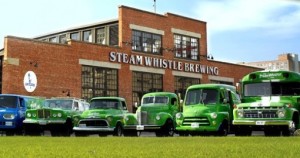An Origin Story and an Employer Branding Story: Excerpts from an Interview with Steam Whistle’s Greg Taylor
 I first heard about Steam Whistle Brewery from Ted Matthews, author of the best-seller Brand: It ain’t the logo…It’s what people think of you.
I first heard about Steam Whistle Brewery from Ted Matthews, author of the best-seller Brand: It ain’t the logo…It’s what people think of you.
In my interview with Ted, he told me all the really cool things that Stream Whistle’s co-founders Greg Taylor and Cam Heaps have done to create a vibrant, authentic brand…and a culture that makes it possible.
I knew I had to learn more.
So I recently did an interview with Greg Taylor. I will be sharing pieces of the interview over the coming months. This segment looks at two stories he shared.
The Origin Story
As I’ve written about elsewhere, your Origin Story helps people understand who you are and why you do what you do. Having a clear and compelling Origin Story is important whether you are a solopreneur or business owner interested in differentiating yourself and building your brand.
If you are an employer wanting to become a Talent Magnet, communicating a fascinating and inspiring Origin Story plays a central role in your Employer Branding strategy.
Leaders of growing companies also should be using Origin Stories as one of their strategies for keeping start-up culture and ethos alive as they scale.
Origin Stories also play an important role in new hire orientation, and your ongoing strategy to communicate cultural norms and values.
In this excerpt, you will hear Greg talking about a defining moment in his life as a young bike courier, when he stumbled upon a very different kind of leader. That chance encounter both shaped his life trajectory and formed the foundation of his leadership philosophy.
An Employer Branding Story
One of my pet peeves in the recruiting and so-called Employer Branding world is the use of generic, say-nothing employee testimonials. If you search Youtube for examples of “Why I love working at….” most of the videos consist of employees saying nice generalities about their employer, things like:
1. “You get to work with really great people here…”
2. ‘It’s a really fun environment…’
3. “They have really great opportunities for growth here…”
If you watch more than two employee videos, they all start sounding alike. How can you differentiate yourself if you sound just like everybody else?
And what do those accolades really mean to the listener? It’s like saying “We really value good communication”.
What does that mean?
If you ask ten people what that means to them, each one would describe different criteria. If you ask for examples of what “god communication” meant, you would hear a wide range of scenarios equaled “good communication”.
This is where stories shine.
If you give an example of why you say “They have really great opportunities for growth here…”, the listener/viewer will have a much clearer understanding of what that looks and sounds like. Thus your message will be more clearly received.
Also, because stories are memorable while clichés and abstract terms and phrases (like the three above) are not memorable, using stories help your message stand out from the crowd. They insure that your message sticks with the viewer/listener long after they have forgotten the other generic messages.
Communicating a Core Value Come By Using a Story
In the second part of the excerpt, you will hear a great example of using a story to communicate one of Steam Whistle’s key values.
When you hear the story, notice how framing the value within a story that includes some dramatic tension and conflict makes the take away message far more “sticky” (to use Chip and Dan Heath’s term).
If Greg had just said “We recognize, and draw upon, the creativity and knowledge of our people…We totally get it that they are a HUGE source of great ideas and innovation”, you might think:
“Well yeah…I know that’s important…tell me something I don’t know.”
Because he frames his message in a story , it makes his point much more memorable.
It also makes the story an excellent example of the type of story you want to include in your Employer Branding.
So…in the recording below, you’ll hear me set up the two stories, then you’ll hear the two stories, and then you will hear a brief debrief by yours truly.
I hope you use them as models for beginning to create your Origin Story and collecting stories that can be used to communicate your Employer Brand and your key cultural values.
If you have questions about how to do either, ask away.
